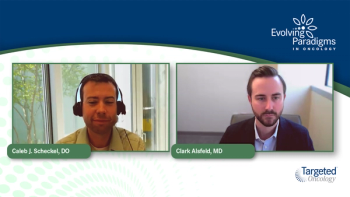
Understanding cGVHD: From Diagnosis to Initial Therapies
A panelist discusses how chronic graft-vs-host disease (cGVHD) is a common posttransplant complication with increasing incidence due to peripheral blood stem cell grafts, older patients, and more unrelated donor transplants, which can manifest in multiple organs and is typically treated with corticosteroids as first-line therapy.
Episodes in this series

Video content above is prompted by the following:
Chronic graft-vs-host disease (cGVHD) is a common complication following hematopoietic cell transplantation, affecting 60% to 80% of patients receiving unrelated donor peripheral blood stem cell grafts. Key risk factors include HLA mismatch between donor and recipient, female-to-male transplants (especially with multiple prior pregnancies), peripheral blood stem cell grafts (which now comprise 90% of adult transplants), advanced patient age, and unrelated donor transplants. Current demographic trends show increasing cGVHD incidence as more transplants use peripheral blood stem cells and treat older patients, with matched unrelated donor transplants now exceeding matched related donor procedures.
The diagnosis of cGVHD is primarily clinical, based on characteristic manifestations across multiple organ systems. Skin involvement may present as scleroderma-like conditions (localized or extensive), poikiloderma, or keratosis pilaris. Joint manifestations occur in approximately 40% of patients with reduced range of motion. Ocular and oral involvement (sicca syndrome) includes dry eyes, dry mouth, and lichen planus–like lesions. Gastrointestinal manifestations can include dysphagia, nausea, vomiting, and diarrhea while genital involvement is more common in women. Most patients with advanced cGVHD present with multiple organ involvement.
Clinical scoring of cGVHD follows the National Institutes of Health consensus criteria, with each organ assigned a score from 0 to 3 based on severity. Global assessment categorizes patients as having mild, moderate, or severe disease. Mild cGVHD can be managed with topical treatments and continued prophylactic immunosuppression while moderate to severe disease requires systemic therapy. First-line treatment typically involves prednisone (1 mg/kg) alone or combined with calcineurin inhibitors for 2 to 4 weeks, but response rates are only approximately 50%. With 4 approved second-line treatments now available, about 20% of patients will still require third, fourth, or fifth-line treatments for difficult-to-treat cGVHD up to 5 years post-transplant.








































